
17 minute read
PREP FOR FLIGHT
Francis Donaldson takes an in-depth look at ensuring your aircraft is safe and airworthy as the Covid restrictions ease…
With the nation looking forward to coming out of the third lockdown, many LAA members are probably wondering about their aircraft, which have spent a good portion of the last 12 months sitting unflown in hangars – and what they will need to do to return them safely to flight. Some owners have taken advantage of the DfT provisions for recreational aircraft doing engine ‘health flights’ over the winter, which will have helped keep the whole aircraft ticking-over nicely ready for the return to normality, but many others have chosen to make ‘staying at home’ their priority. Aimed particularly at this latter group, this article gives practical advice on how to ensure your aircraft is in a safe and airworthy state when the Covid-19 quarantine restrictions are relaxed, and also includes suggestions about actions that might be taken to minimise problems later. It’s based on the content of Technical Leaflet TL 2.32, which was initially published last April, simplified and re-shaped to reflect the current scenario.
Engines
For engines, the first port of call should be the maintenance or operator’s manual, which will most likely include advice on how to bring the engine back into service after disuse. The references at the end of this leaflet include links to the maintenance advice for the popular Continental and Lycoming engines, and Below The Lycoming camshaft can exhibit corrosion issues if not flown regularly, although modern corrosion inhibiting oils certainly help eradicate the problem. also, for the latter, the very helpful Lycoming Flyer which provides a wonderful compendium of advice for all aspects of looking after these engines. See also the TADS for the engines, which you can download from the LAA website, which include live links to much of this and other useful information. Unfortunately, due to the all the other conflicting priorities during the lead-up period to each lockdown, and the uncertainty over how long each lockdown would last, most of us will not have had a chance to inhibit our aircraft’s engine beforehand, or carry out any preparation at all for a period of disuse. Some engines are more prone to problems of neglect than others, so we shouldn’t assume that just because your hangar-mate got away with ‘just firing up his engine and going flying’, we can do the same… In any case, even if your carefree chum doesn’t come a cropper straight away, damage caused by a period of neglect may not materialise until months or years later, when the effects of that corroded bearing or camshaft lobe comes home to roost. On the plus side, while the maintenance manuals for most engine types naturally don’t encourage it, despite the best of intentions, in pre-Covid times many of us have routinely had a voluntary gap in our flying over three or four months during the worst of winter, without taking special measures to tend to our aircraft’s engine, either during this time or on its return to service. So, we should not assume that our neglected
engines are ruined – but nevertheless, a cautious approach and particular safety efforts would be even more appropriate this year than others. Not least because with so many aircraft having been laid up worldwide, if the suppliers of your engine find they are suddenly faced with orders for thousands of replacement camshafts or cylinders, you may find it takes the whole of this season to get hold of the parts you need – or the manufacturer may have ceased supporting that engine and invite you to buy a shiny new one instead, blowing a huge hole in your flying budget.
Please, don’t just ground run…
Hopefully, during the period of inactivity, you did not give the engine a series of short ground runs which, other than keeping your enthusiasm alive, would probably have done more harm than good to the engine. A short ground run is unlikely to get the engine oil hot enough to evaporate moisture, encouraging water to pool in pockets within the crankcase and other expensive components. Over time, this water becomes acidic which further exacerbates internal corrosion.
There will always be some condensation inside the engine from water in the blow-by gas, as well as from atmosphere via the breather, but getting the engine properly hot means the acidic water suspended in the oil or sitting in the bottom of the sump will boil off. Realistically, the practical way to get the engine’s core temperature that hot is to fly it – and probably, for at least half an hour.
Oils
If you are using an engine oil which includes a corrosion inhibitor, or the engine has been in service for long enough for the oil to form a protective internal varnish-like layer coating all internal surfaces, then for most engine types, corrosion problems will be minimal unless the engine is left for a significant time. Detergent oils and multigrade lubricants, such as AeroShell ‘W+’ type, all contain some form of corrosion inhibitor. And if a well-used engine has run all its life on straight oil, it is likely to be nicely coated in a protective black tar inside – except of course, on the bearing surfaces.
Remember though that if yours is a new or just-overhauled engine that is being run-in on ‘straight’ oil, you mustn’t add aftermarket corrosion inhibitors or use other oil types which would prevent the engine successfully running-in, in which case the engine would always suffer high running temperatures and poor oil consumption.
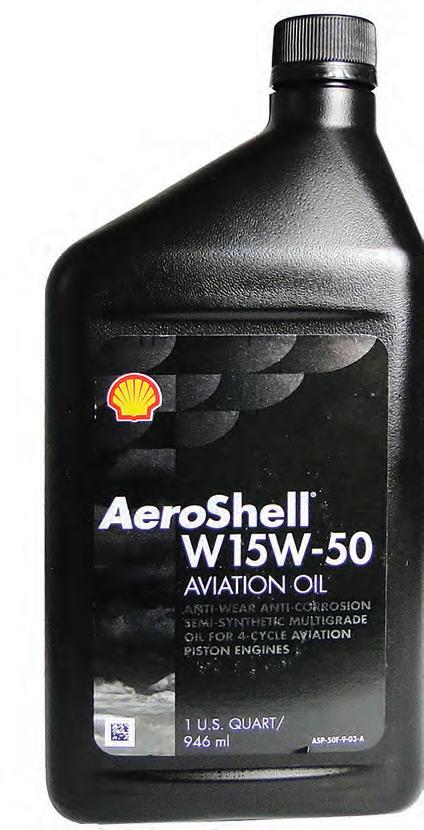
Lycoming camshafts
Lycoming engines can have cam problems after a long lay-up, especially if using straight oils without any corrosion inhibitor. The configuration of these engines means that the cams are only splash-fed and over a long period of being static, the oil film between the cams and cam followers can break down. This leads to rapid cam and follower wear in future Below An example of the more complex oils now available. Seek expert advice about suitability for your type and methodology of a change. running – once the camshaft lobe’s hardened surface is worn away, the lobe soon transforms from egg-shaped to almost round, releasing damaging metal into the lubrication system (likely ending up on the magnetic plug) and seriously reducing the ‘lift’ on the associated valve. That’s the reason Lycoming advocate regular ‘health’ flights – the Lycoming Flyer gives advice about how to prevent this happening, including by internal inspections with a borescope and bringing forward the oil and filter change. The Rotax 9-series and Continental engines, with their underslung camshaft arrangements don’t normally suffer from cam problems, especially if running on multigrade oils with good anti-corrosion additives. VW engines, despite their Continental-like configuration and low-set camshafts, can suffer in the same way as Lycomings after a long period of disuse, so good inspection and ongoing vigilance are important. VWs also sometimes suffer from valve seat and valve stem corrosion after being left for a few months, which can lead to sticking valves and no compression. Consequently, the engine cannot start, rough running – or worse, the valve head separating from its stem after a few hours running, because of fatigue cracks triggered by the corrosion pits in the stem. With a VW, it’s so quick and easy to whip the heads off and do a top overhaul that your Inspector might well suggest doing this anyway, so that you can check the valve stems and guide wear and while you’re at it, clear out the port passages and grind in the valves. If you are in any doubt about the valves, good quality aftermarket valves for VWs are so cheap – by aircraft standards – that it doesn’t make sense to do anything but replace them. Even new barrels and pistons are low-cost (about £150 for a complete set!) so it isn’t worth replacing pistons or rings in isolation, you might as well replace the lot while you’re at it. Just be sure to torque up the nuts on the head studs carefully afterwards – using the bespoke manual for your particular aero-conversion (Aerovee, or the Peacock VW instructions, for example) or in the absence of anything else, the ubiquitous Haynes manual.
Fuel
When it comes to re-commissioning the aircraft after the lockdown, probably the most important issue is the contents of the fuel tanks. Have the tanks got water in them? This can be a particular problem if the aeroplane has been parked out in the rain for any length of time, but even in a dry hangar, condensation in a part-empty fuel tank can lead to water in the fuel system.
Don’t even consider flying without doing a thorough water drain check first, from ALL the drain points, and including the contents of filters and float bowls – if the float bowls aren’t designed to be removed, that’s what the float chamber drain plugs are for. Mogas is notorious for going stale, being supplied in the expectation that in a road vehicle it will be consumed within a few weeks of purchase. Stale mogas may have evaporated away some of its octaneenhancing additives, leading to an increased
likelihood of ruinous detonation. Stale fuel also has reduced volatility and very often causes problems at start-up, but don’t be misled into thinking that just because the engine starts with it, the fuel is good to fly with. Unlike in a car, you can’t hear detonation happening in an aero engine so the first sign of ‘stale fuel’ problems might be when the engine’s cylinder heads distort, or a piston breaks up when climbing out at high power. Worryingly, in some cases the chemicals created as mogas goes stale have appeared to attack non-metallic fuel tanks, fuel pipes etc., even though these were resilient to fresh fuel. This has caused some serious issues with integral tanks in composite-winged aircraft, which have in some cases threatened to scrap the wings and make the aircraft an economic write-off. If your aircraft has non-metallic tanks, particularly if they’re embedded in the structure (like the Europa) or form part of the structure (Jabiru four-seaters), then this is definitely not an issue to ignore. But frankly, whatever the tanks are made of, the answer is clear (and indeed, embedded in the requirements for mogas fuel) – any mogas that’s more than a few months old must be drained out and replaced. Even avgas has a limited life, although it is a much more stable and uniform product. A 100LL fuel that’s over six months old should be treated with suspicion. Whatever the fuel type, after a long time out of use we should pay special attention to water drain checks Below Get those cowlings off and have a good look around. This exhaust problem would likely have been spotted initially as a crack. and while you’re about it, check all fuel filters. There’s a mould-like form that’s sometimes found growing on fuel filter elements, apparently thriving off the heady combination of water condensate, petrol and petrol vapour found within. The build-up of this almost invisible microscopic mould can very effectively stop the fuel flow – so to guard against this we’d suggest that any disposable type fuel filters are replaced as a matter of course.
Airframes
Part of the preparation for flight should include giving the aircraft a good clean, which will not only remove possibly corrosive dirt and dust from the surfaces, it will also present a good opportunity to inspect every square inch of its surface at the same time. Be careful not to scratch the surfaces when you clean them – especially the Perspex windscreens and canopies. The aircraft’s maintenance manual may give advice on suitable cleaning products, which may be very different on a composite aircraft than a metal one, for example. Whatever the type of airframe, be very careful before using anything aggressive on its surfaces, such as when trying to remove mildew. It’s generally better to dissolve and float away dirt with lots of water than to try to scrub it away with a rag.
Furry and feathered friends
Another implication of an aircraft having been left
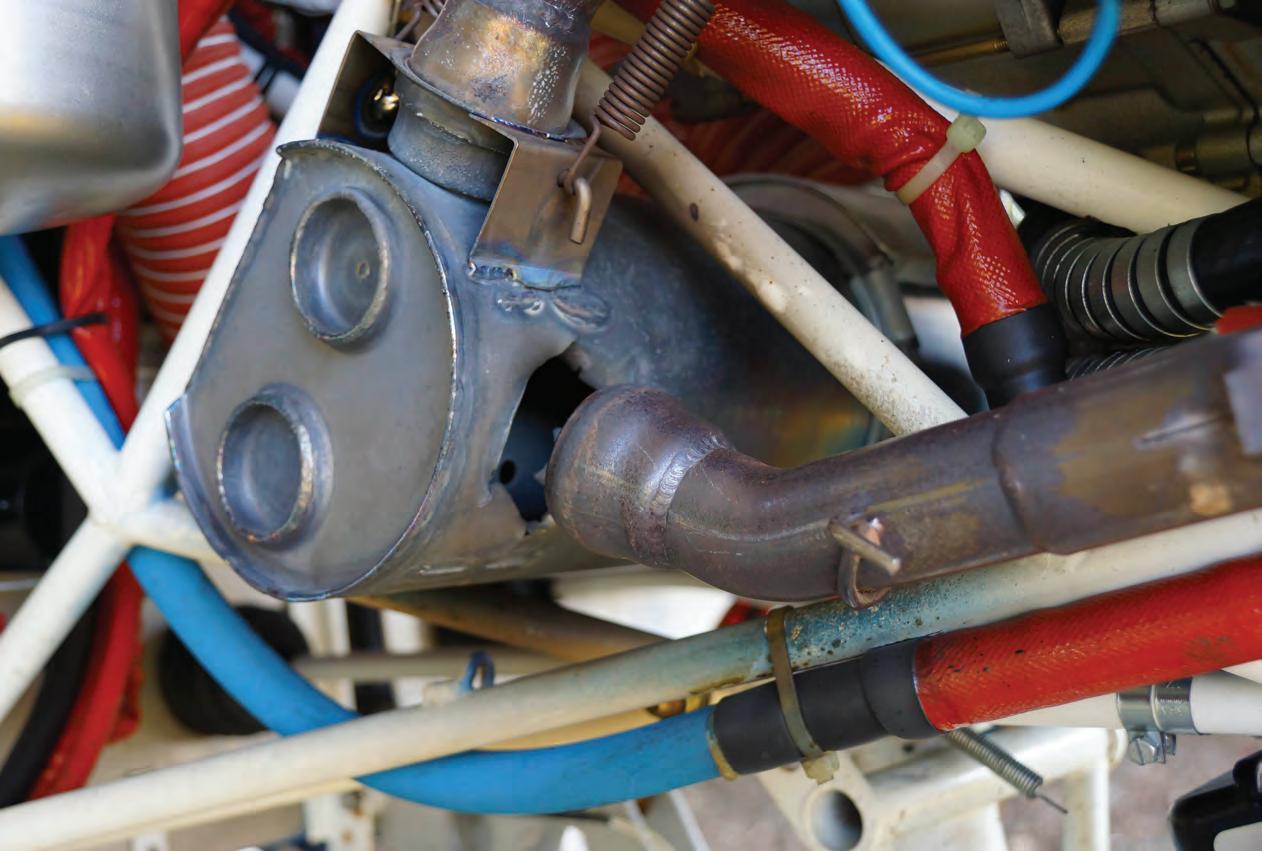
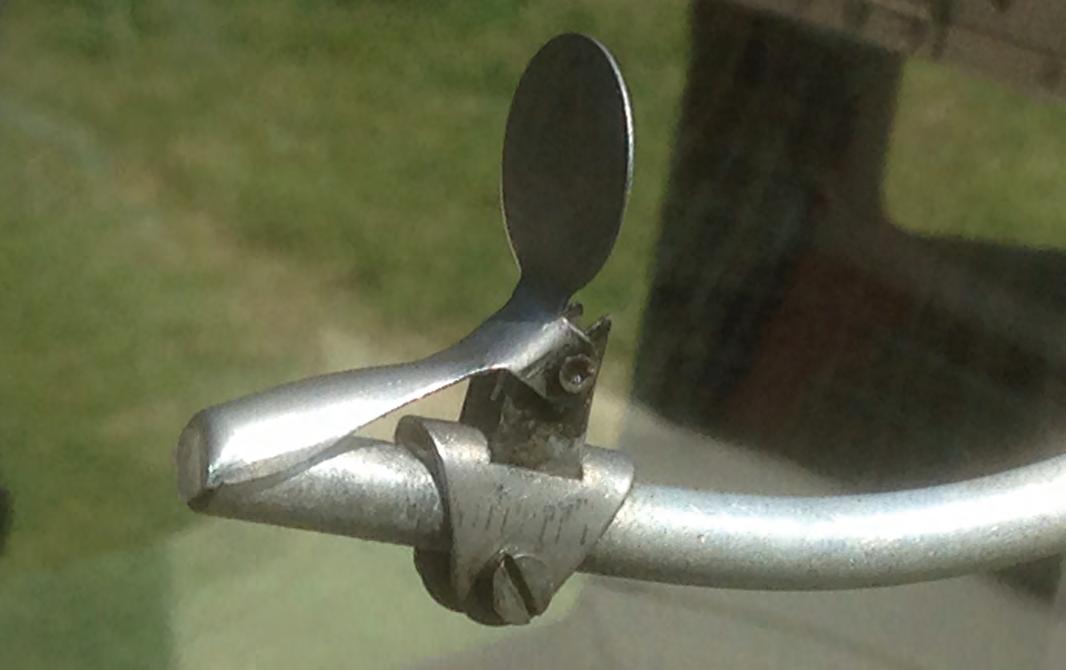
undisturbed, particularly in the spring, is the possibility of wildlife having taken residence within. Watch out carefully for the tell-tale signs of nest-building by birds or rodents and, in the case of the latter, the all-tooobvious smell. You’ll need to remove all cowlings and access panels to check the airframe’s internals for unwanted guests. You can find advice on dealing with rodent infestation in the FAA’s repair manual AC43.13, which is available online (see references at the end of this article). Insects can also cause problems by blocking vents in fuel tanks and pitot and static ports, which will also need carefully checking.
Cables, wires and hinges
Other parts of the aircraft worthy of some pre-flying TLC are the control cables to the flying controls and wire bracing of biplanes and other externally braced types. Control cables can be treated with lanolin – put some on a piece of rag and slide it up and down the exposed lengths of cable, which will also quickly reveal any broken strands by snagging in the cloth (watch your hands). Lubricate control surface hinges, door hinges etc., as indicated in the aircraft’s manual and check that control surface travels are all ‘full and free’.
Propellers
If it’s a simple wooden propeller, make good any blemishes in the surface finish, especially if they have exposed the underlying wood – typically along the leading or trailing edges where the paint finish may wear or crack. Cracks can allow water to penetrate under the finish and undermine its adhesion over a wide area, which could quickly lead to the prop’s demise. When were the prop bolts last torque-checked? February’s Safety Spot included a dramatic account of a Stampe that lost its prop in flight, apparently because of ignoring this simple check. Remember, the hubs of wooden props swell and shrink in the damp and dry air of the seasons, and prop bolts need adjusting accordingly or you risk either a loose prop or a crushed prop hub – neither of which will bode well for their longevity. If it’s a composite-bladed prop, the blades need looking after with equal care to a wooden propeller, but don’t forget to take a close look at the (usually) aluminium alloy prop hub too. There’s been problems with corrosion in these hubs being left untreated, with disastrous consequences – perhaps a case of the tell-tale signs having been ‘sight unseen’ within the spinner. Corrosion in any highly stressed metal component is simply unacceptable, and the propeller hub definitely falls within this category. If it’s a variable pitch or constant speed propeller, hopefully it’ll have been left covered up and, if it’s a two-blade example, it’s been parked with the prop horizontal so that rain does not get into root bearings and pitch change mechanism. Watch out for signs of
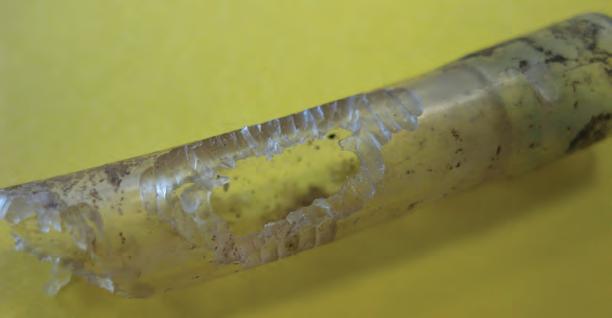
Top Useful pitot cover – if yours is open to the elements, make sure it is clear of dirt or debris – not by blowing down it when still connected!
Above This instrument hose was gnawed at by rodents, so have a good look around to check for such damage and debris.
Right The root area of this ground adjustable prop is dangerously corroded. Have a really good check of all critical components for corrosion problems.
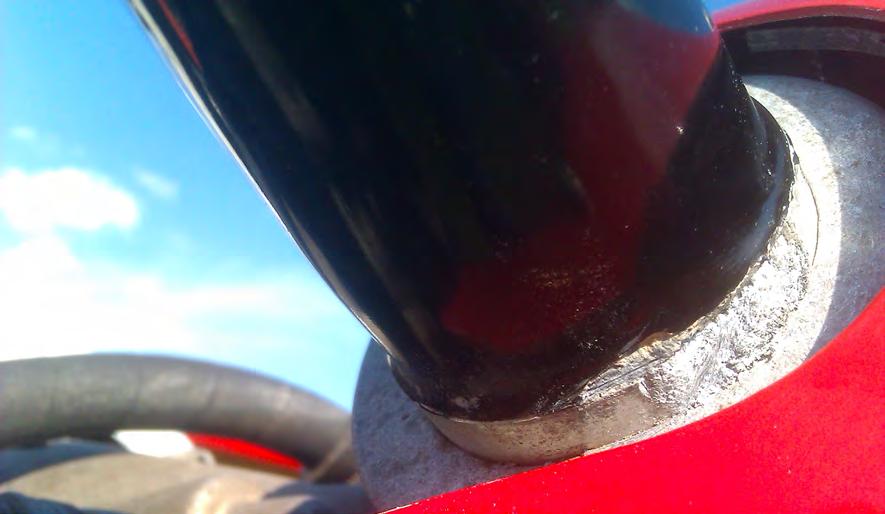
corrosion on the blades leading to bubbling of the paint, which might quickly lead to disastrous blade failure if left untreated. If it’s found, best call your prop-shop for advice as it probably means that the prop needs a bare-blade inspection and overhaul before returning it to service.
Undercarriage
Standing static for a long period may have caused problems in this area. Tyres, particularly if not inflated to a high pressure, may have developed a ‘flat spot’ if they’re not turned for ages, which will create a troubling vibration when you come to take off. If possible, jack each wheel in turn off the ground and check it for flat spots by giving it a spin – that way you’ll also get a feel for the condition of the bearings. While you’re at it, consider having the wheels off, check the rims for cracks and corrosion, take a look at the bearings, washing them out and re-greasing them ready for the new season. How are the tyre sidewalls? Long exposure to sunlight may have caused cracking, particularly if the tyre has had to take the aircraft’s weight after going flat. If you find a flat spot, inflate the tyre to near its rated pressure and leave it for a while (preferably, if safe to do so, with the aircraft’s weight still off it) to recover its original shape. Remember to let the pressure down to the maximum pressure allowed for use in the aircraft before flight, however, or your first flight after the lockdown may be marred by a much bouncier landing than you deserve! You should also check that the brakes aren’t stuck or dragging, and look out for telltale drips, puddles on the floor or other signs of brake fluid leakage.
Electrics
A conventional lead-acid battery will probably respond best to trickle-charging when you want to bring it back to life, but for any other of the more energy-dense alternatives, check the instructions for advice on the best procedure to recover them from a drained condition. Some are easily destroyed by being allowed to discharge below a certain voltage, others respond better to deep cycling than a continuous trickle. If the battery’s flat, don’t be tempted to swing the prop or jump start the battery. The high rate of charge from an alternator / generator can damage batteries. Fix the problem before going flying, even if it means a day’s delay. If, with a charged battery, the starter motor won’t turn when you energise it, suspect a poor connection to the battery, or a poor earth. If the motor’s earth is suspect, be sure not to accidentally end up passing the starter motor earth current by default, through the lower gauge instrumentation wiring, which will simply go up in smoke. The current can also pass through the throttle or mixture cables, which won’t take kindly to this kind of treatment either, not to mention causing alarming fireworks in the cockpit.
Paperwork
As well as the aeroplane being in a sound condition, be sure to check that your paperwork bundle is also all in order. Make sure that your Permit to Fly is valid, logbooks are up to date, your PPL and Medical are current, etc. If you’ve adjusted any control cables, have you had duplicate inspections done after locking them up? If you’ve done pilot maintenance, have you made out your logbook entries? That ‘do not fly’ notice you put in the cockpit months ago – what was that about? If you put the aircraft’s insurance on ‘ground risks only’ during the lockdown, have you remembered to reactivate it to include flight risks?
Don’t worry, but stay safe
If all the above sounds alarming, it really needn’t. After all, each year hundreds of aeroplanes get to be left to their own devices for one reason or another for months on end. Generally, these aircraft are brought back to life with the minimum of problems, an appropriate inspection, and refreshing the fuel and oil. But without doubt, extra vigilance and a cautious approach will certainly help you avoid being one of the unlucky ones. After the long gap, and likely the limited flying many of us did last summer, we’ll be rusty about our flying, too. We’ll do well to limit our flying to simple sorties initially, and avoid tricky crosswinds and difficult navigation until we’re fully back in the groove. There’s some excellent online advice available from the General Aviation Safety Council at www.gasco.org.uk. And remember, there’s also a cadre of LAA Coaches ready and waiting to help you as well as the LAA Inspector team. Happy landings! ■
References and links
Engine TADS https://tinyurl.com/64zvu587 Lycoming: https://tinyurl.com/2vca3n9w Lycoming Flyer: https://tinyurl.com/47mwuwhw
Continental:
http://www.continental.aero/home FAA AC43.13: https://tinyurl.com/bnb9zs78










